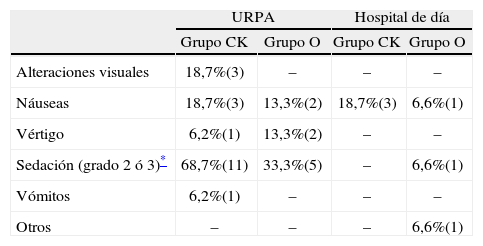Comprobar la eficacia de la premedicación con clonidina, asociada a ketamina intraoperatoria a bajas dosis, para disminuir la necesidad de analgésicos opioides postoperatorios en la colecistectomía laparoscópica ambulatoria
Pacientes y métodosSe realizó un estudio prospectivo en pacientes sometidos a colecistectomía laparoscópica ambulatoria desde noviembre de 2005 a noviembre de 2006. Se distribuyeron de forma aleatoria en 2 grupos, grupo CK a los que se administró clonidina (0,15mg vía oral 60minutos antes de la cirugía) y ketamina (bolo de 20mg intravenoso seguido de perfusión intraoperatoria de 20mgh–1), y grupo O a los que no se suministró esa medicación. Se determinó la Escala Verbal Numérica (EVN) durante el postoperatorio, número de rescates analgésicos necesarios para obtener un valor inferior a 3 y efectos adversos a la medicación.
ResultadosSe incluyeron 31 pacientes (16 en el grupo CK y 15 en el grupo O). 25% de los pacientes necesitaron 2 rescates en el grupo A, mientras que en el grupo B 53,3% necesitaron 2 ó 3 rescates. Presentaron efectos adversos un 87,5% en el grupo CK (principalmente alteraciones visuales, sedación y nauseas), y un 46,7% en el grupo O. Esta diferencia fue significativa durante su permanencia en la Unidad de Recuperación Postanesté-sica (URPA).
ConclusionesLos pacientes con clonidina y ketamina precisan menos analgesia adicional con opioides para alcanzar valores de dolor leve (EVN menor de 3) pero tuvieron más efectos adversos durante su permanencia en URPA, aunque no retrasó el alta hospitalaria
To determine the efficacy of premedication with intraoperative clonidine in association with low-dose ketamine to reduce the need for postoperative opiate analgesia in outpatient laparoscopic cholecystectomy.
Patients and methodsWe performed a prospective study of patients undergoing outpatient laparoscopic cholecystectomy between November 2005 and November 2006. The patients were distributed randomly in 2 groups: patients in the clonidine-ketamine group received clonidine (0.15mg orally 60minutes before surgery) and ketamine (20-mg intravenous bolus followed by intraoperative perfusion of 20mg.h–1); patients in the control group did not receive this medication. Pain assessed on a verbal numerical scale, number of times rescue analgesia was required to achieve a value below 3, and adverse effects of the medication were recorded in the postoperative period.
ResultsThirty-one patients (16 in the clonidine-ketamine group and 15 in the control group) were enrolled. Rescue analgesia was required on 2 occasions by 25% of patients in the clonidine-ketamine group and on 2 or 3 occasions by 53.3% of patients in the control group. Adverse effects were reported by 87.5% of patients in the clonidine-ketamine group (mainly visual disturbances, sedation, and nausea) and by 46.7% in the control group. This difference was significant during the patients’ stay in the postanesthesia recovery unit.
ConclusionsPatients receiving clonidine and ketamine required less additional opiate analgesia to achieve mild pain values ( < 3 on the numerical verbal scale) but suffered more adverse effects during their stay in the postanesthesia recovery unit. Discharge was not delayed, however.
Artículo
Comprando el artículo el PDF del mismo podrá ser descargado
Precio 19,34 €
Comprar ahora










